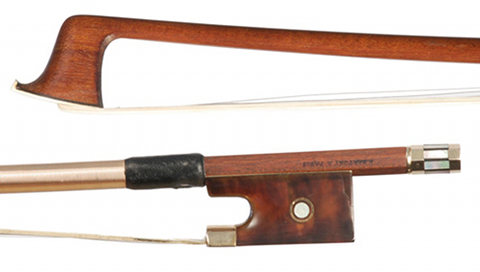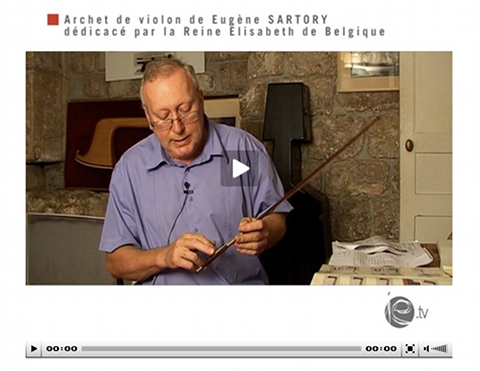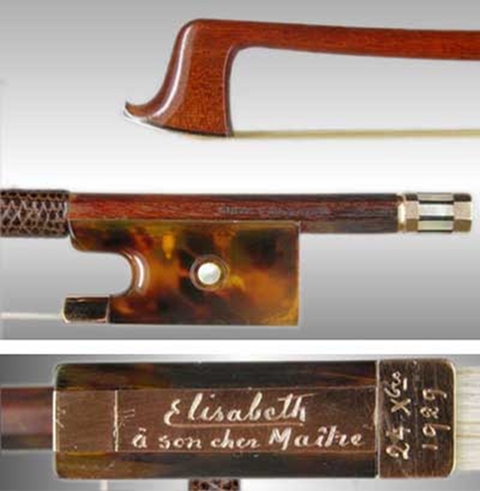EUGENE SARTORY; BELGIAN MOUSTACHES HIDING A FRENCH SMILE
According to a Tuscanian proverb "All poets miss a verse," , but at a first glance it seems that the "poet" Sartory, has all verses, although deepening the story of his life we realize that he is missing something, even if he is completely not-guilty about it.

Violin bow tortoise and gold Eugène Sartory
Great manual skill and speed of execution, certainly no lower than that one of Dominique Peccatte; sense of style and harmony, as in few other past, contemporary and future colleagues, ability to select and manage his staff and optimization of the product furthermore a pure trader, comparable to his esteemed colleague J.B Vuillaume, a sharp guy. Such a character would seem to have everything in order not only to become a great craftsman, but the number one, if he had not had such a serious deficiency.
Making no exception, he, too, was born in Mirecourt on September 22, 1871 by Francine Catherine Buclier and Joseph Eustache Sartory, bowmaker .
After having started with his father in the second half of the '80s, when he is still very young, he moves to Paris to learn and improve his training and this is exactly the “verse” that Sartory is missing .
Arriving in Paris, he settles in the laboratory by Charles Peccatte, who will become his teacher for a short period, then he moves to Joseph Alfred Lamy "Pere's workshop. With the utmost respect for all Lamys, and with the minimum one for Peccatte, the former was a good craftsman, the latter would have probably been a gardener throughout his life if he didn't have that surname. You understand that the competence level of his teachers was not quite suited to his talent.
We talk about Dominique Peccatte like a great, definitely greater than Sartory, but his teacher was J.P.M. Persoit, one of the greatest of all time, and not Alfred Lamy! If your teacher does not have clear ideas, he will teach you wrong things, and if you want to get the any results, you will have to find the solution to some problems by yourself , just wishing that your talent could be enough.
Sartory did not succeed in it. Despite a really amazing talent, he is not able to equal names such as Tourte, Persoit or Pajeot, although potentially he was not so far away. Without a teacher worthy the name, he only became the number one in the modern period of the French bowmaking ; light years away from his contemporaries.
At the age of eighteen, in 1889, he opens his own business at 12, Boulevard Bonne Nouvelle.
In 1899 the first signals as outsider , on April 1st he marries Marie Joséphine Jaquet, daughter of the famous violin makerJaquet-Gand . The couple gave birth to two daughters, Renée and Gabrielle, the latter will then marry the luthier Georges Dupuy.
In 1902 he moves his laboratory for the first time to 13, Faubourg Poissonnière; choosing this location for its closeness with the Conservatory.
Until 1910 he is often forced to build bows mounted in nickel silver or for other luthiers. In 1912 he achieved a certain fame and independence; partly because of the crowding of craftsmen who had settled in the area, he decides to move again, this time away from the Conservatory. He bet on himself and he's right; the clients even go through the whole city to reach Him.
His fame grows and he needs labor force. Before the war, which will temporarily stop his activity, he hires two Germans,Prell and Hoyer. On his return, he comes back in a great style. After the First World War, Louis Morizot, Jules Fetique, andLouis Gillet were working for him.
Because of the war, the European economy is obviously damaged and the producers are forced, against their will, to look for work overseas. Even Sartory tries to do it , but the American experience was not too pleasant for Him.
He went to New York in 1921, because he heard of some cases of bow marked with his name , but that did not come from his laboratory. He issued a lawsuit that he lost because of the American laws, as the French are writing.
In 1933 his first wife dies, but he is not discouraged, and in February of '35, he marries his second wife, Emilie Joséphine Augustine Sartory.
He dies on March 5, 1946 and, as per his own will, he was buried in his native village: Mirecourt. As witness of how much this man has done for the French bow making, many awards for his work are left .
Bruxelles Expo 1887, Lyon Expo 1894, Universal Paris Expo 1900, Lieges Expo 1905, Milan Expo 1906, London Expo 1908.
The most awarded of all. Loved, envied, and hated like Dominique Peccatte.
Next week we will deal with the stylistic/ mechanical innovations by Eugène Sartory, for the moment I found a little movie where M° Raffin speaks in general terms about the evolution of the modern bow and describes a particular violin by Sartory, mounted in tortoise shell and gold and given by Queen Elizabeth of Belgium to Eugène Ysaye .

Click and watch the video

Violin bow by Eugène Sartory in tortoise shell, gold and mother-of-pearl given to Eugène Ysaye by the Queen Elisabeth from Belgium.
So long
Paolo
|